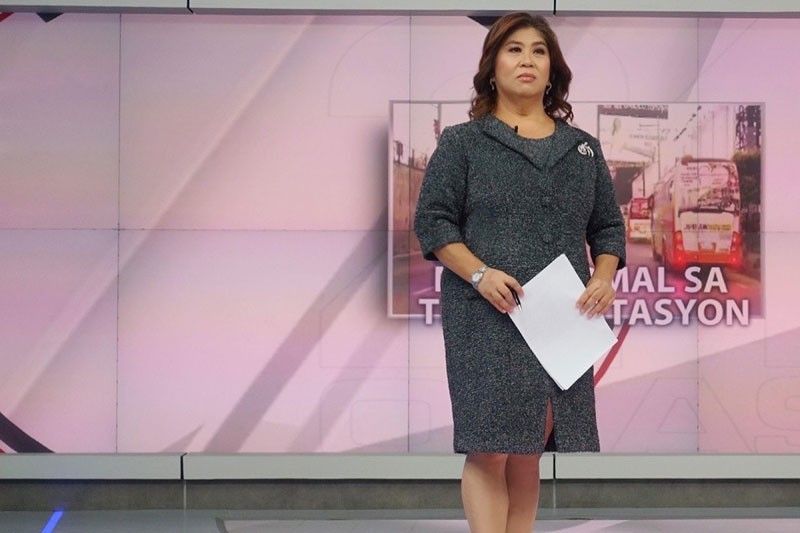Taking risks to deliver the news


Name it, she’s got it. All the awards a journalist can ever dream to get, that is. As the cliché goes, her cup runneth over and yet, Jessica Soho is not about, as another cliché goes, ready to rest on her laurels. She stands out as her best trophy among the dozens that occupy every wall of her house.
Jessica is pinch-hitting for Mel Tiangco and Atom Araullo for Mike Enriquez, the senior hosts of the GMA newscast 24 Oras. Jessica is true to the network’s tagline — Walang kinikilingan, walang pinoprotektahan, walang kasinungalingan, serbisyong totoo lamang. Co-anchor Vicky Morales adheres to that, too.
How do you manage to look so calm and so cool (and so well-groomed) on 24 Oras in this crisis?
“For the life of me, I can’t claim credit for how I look on 24 Oras, hehehe!!! AJ Alberto is the stylist who picks my outfits; Ricky Balaguer (Mader Yari) does my hair and make-up. Kilala mo naman ako noon pa. I come from a background of wearing jeans, T-shirts and those photographer’s vests when I was covering conflict and calamities.
“I may look calm and cool on camera but I’m anything but. I’m really a jumble of nerves; ready for anything because this is live TV. In between takes, I read the scripts several times over. When we’re down to the last two segments then Vicky and I get chatty; kwentuhan about life and stuff.”

You are taking so many risks in your “true service to the Filipinos” to deliver the news. What precautions do you take?
“I miss being careless! Life has become an endless cycle of handwashing, disinfecting, putting on a mask and worrying!!! I wish I could go on a lockdown, too, but now more than ever, people need to know what’s happening. I was telling our reporters earlier on that we live for these moments, despite the risks. This is what we all signed up for.”
How much time do you spend going to GMA and back home (may service ba courtesy of the network), and what vitamins or supplements are you taking?
“I live in Quezon City so it’s a short drive to and from work. The network also provides free shuttle service (also masks, meals and even morning and afternoon merienda) to those who need to work.
“I take Vitamin C and zinc and do some stretches and breathing exercises under the morning sun, usually for 20 minutes before 10 a.m.”
Do you observe all the do’s and don’ts upon arriving home?
“My hands are dry from disinfecting! From work, I go straight to the shower. At work, I hate it when I have to rush because I really like to have enough time disinfecting my work areas as well as putting my mask on, properly.”
You continue uninterrupted your Sunday show KMJS (Kapuso Mo, Jessica Soho). How do you do it?
“The credit belongs to the hardworking, most creative KMJS staff, led by Program Manager Lee Joseph Castel and executive producer Tetet Ranoco. They are the ones who tirelessly work for the program and never run out of new concepts and ideas. I may have trained them in the beginning but they have gotten so good, I just follow their orders now.”

How do you keep updated (on issues and current events)... by reading newspapers and watching newscasts?
“I read the newspapers on my iPad; The New York Times, on my cellphone. I regularly check CNN International and BBC for foreign news. Once I get to work, I also check our own news menu.”

How does this crisis compare to the other crises (“lost” at sea, etc.) you’ve been through?
“I think this pandemic is this generation’s ‘panahon ng Hapon.’ One of my fondest childhood memories is listening to the stories of my maternal grandmother, Sixta Aspiras or Apo Baket, about how they survived the Japanese occupation. They hid rice in the ceiling so that when the Japanese came, they wouldn’t have rice to confiscate. During this crisis, rice has also become an even more precious commodity so I donated some to our frontliners.”
How do you fight an enemy that’s invisible, much less protect yourself against it?
“I worry for our news teams, especially those who are constantly exposed at the risk of getting infected. This does not at all compare to any of the conflicts or calamities I covered in the past. We lost our way going to the Spratlys, survived a landmine explosion in Afghanistan, etc., but once we were out of the danger zones, end of story. In this war against COVID-19, the whole world (including our homes and workplaces) is a battlefield.”
What changes do you see in news reporting when the crisis is over?
“When I was running our newsroom, we were always on the lookout for the best cameras; those with the sharpest resolutions. Now, pictures and videos shot by cellphone cameras have become acceptable and common. Never mind if the shots are grainy and amateurish. The story is what’s important, now more than ever. It’s really the story that matters most.
“It will be a while before we can do face-to-face interviews again. I think KMJS may have innovated the new selfie (which is usually done once the interview is over and before the interviewer and the subject say goodbye to each other). The crew takes my picture with the computer screen with my interviewees on it.”
(E-mail reactions at [email protected]. For more updates, photos and videos, visit www.philstar.com/funfare or follow me on Instagram @therealrickylo.)
- Latest
- Trending


























 Exclusive
Exclusive






